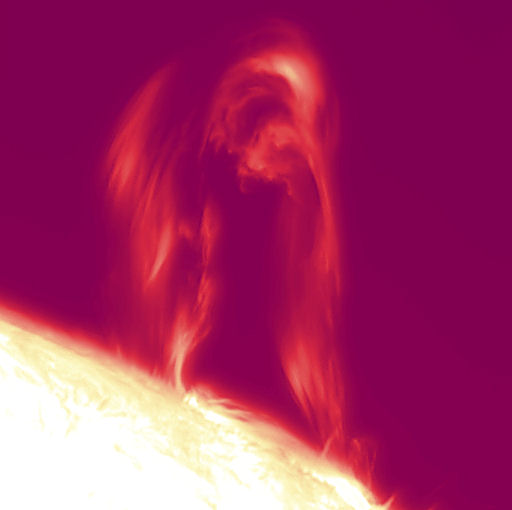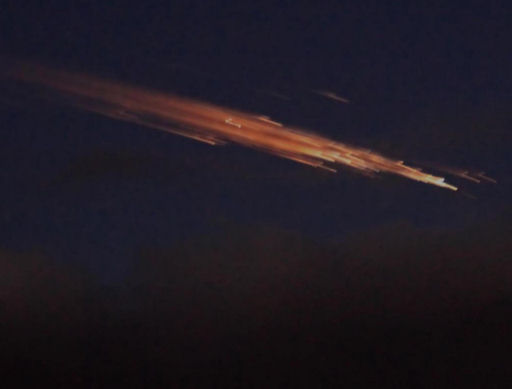
NIGHT AFTER CHRISTMAS SKY SHOW: When the sun goes down tonight, step outside and look west. Venus and the crescent Moon have gathered together for a lovely night-after-Christmas conjunction in the sunset sky. Science@NASA has the full story.
CME TARGETS MARS, EARTH: New sunspot 1387 erupted during the late hours of Christmas Day, producing an M4-class flare and hurling a CME toward Earth and Mars. Click to view an animated forecast track prepared by analysts at the Goddard Space Weather Lab:
The CME is expected to deliver a glancing blow to Earth's magnetic field on Dec. 28th at 1200 UT and a direct hit to the planet Mars on Dec. 30th at 1800 UT. Using onboard radiation sensors, NASA's Curiosity rover might be able to sense the CME when it passes the rover's spacecraft en route to Mars. Here on Earth, NOAA forecasters estimate a 30-to-40% chance of geomagnetic storms on Dec. 28th when the CME and an incoming solar wind stream (unrelated to the CME) could arrive in quick succession. High-latitude sky watchers should be alert for auroras on Wednesday night. Aurora alerts: text, voice.
BEAUTIFUL BLAST: After three years of deep quiet, the sun woke up in 2011. Sunspots and solar flares became commonplace again as long-awaited Solar Cycle 24 got underway. One of the most beautiful eruptions of the young solar cycle occured just this past weekend. Rogerio Marcon of Campinas SP Brasil photographed the blast on Christmas Eve:
"I made a time-lapse video of the eruption," says Marcon. "What a wonderful Christmas present." While Marcon was recording the event from Earth, NASA's Solar Dynamics Observatory was doing the same from Earth-orbit. It was beautiful up there, too.
This explosion was not Earth-directed. Next time, however, could be different. The source of the blast, sunspot 1386, is turning toward Earth, increasing the chances of a geoeffective flare in the days ahead. Solar Flare alerts: text, voice.
more images: from Philippe Roucheux of Joigny, Bourgogne, France
RUSSIAN RE-ENTRY: The body of a Russian rocket that propelled a Soyuz spacecraft toward the International Space Station on Dec. 21st fell back to Earth on Christmas Eve. Roman Breisch sends this picture of the re-entry from Erdweg, 20 miles west of Munich, Germany:
"This is what the Christmas star looks like in the 21st century," says Breisch. " The decaying rocket was spectacular look as it wove over the night sky from West to the East, getting brighter and brighter and splitting up into hundreds of shiny pieces."
Two videos of the re-entry are being widely viewed on Youtube: #1, #2.
Meanwhile, the three astronauts (Don Pettit, Oleg Kononenko and Andre Kuipers) who rode this rocket to Earth orbit are settling in comfortably on the International Space Station. Don Pettit's return to the ISS is welcomed by readers of Spaceweather.com, who look forward to new episodes of Saturday Morning Science and Pettit's trademark astrophotography.

![]()
Solar wind
speed: 344.8 km/sec
density: 1.0 protons/cm3
explanation | more data
Updated: Today at 1415 UT
![]()
X-ray Solar Flares
6-hr max: C5 1150 UT Dec26
24-hr: M1 0227 UT Dec26
explanation | more data
Updated: Today at: 1400 UT
![]()
![]()
![]()
Daily Sun: 26 Dec 11
![]()
![]()
New sunspot 1387 is crackling with M-class flares. Credit: SDO/HMI
![]()
![]()
![]()
Sunspot number: 66
What is the sunspot number?
Updated 25 Dec 2011
Spotless Days
Current Stretch: 0 days
2011 total: 2 days (<1%)
2010 total: 51 days (14%)
2009 total: 260 days (71%)
Since 2004: 821 days
Typical Solar Min: 486 days
Updated 25 Dec 2011
The Radio Sun
10.7 cm flux: 143 sfu
explanation | more data
Updated 25 Dec 2011
![]()
![]()
![]()
Current Auroral Oval:
![]()
Switch to: Europe, USA, New Zealand, Antarctica
Credit: NOAA/POES
![]()
![]()
![]()
Planetary K-index
Now: Kp= 0 quiet
24-hr max: Kp= 1 quiet
explanation | more data
![]()
Interplanetary Mag. Field
Btotal: 3.8 nT
Bz: 2.0 nT north
explanation | more data
Updated: Today at 1417 UT
![]()
![]()
![]()
Coronal Holes: 26 Dec 11
![]()
![]()
A solar wind stream flowing from this coronal hole could reach Earth between Dec. 28th and 30th. Credit: SDO/AIA.







